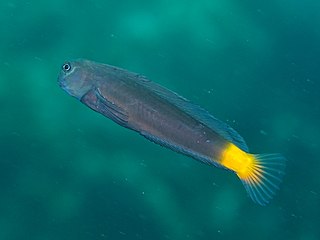
Ecsenius namiyei, commonly called black comb-tooth blenny or Namiye's coralblenny, is a species of marine fish in the family Blenniidae. The specific name honours the Japanese zoologist and museum curator Motoyoshi Namiye (1854-1915).
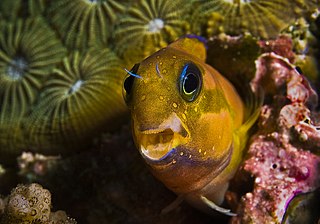
Ecsenius midas, known commonly as the Midas blenny, Persian blenny, lyretail blenny or golden blenny, is a species of marine fish in the family Blenniidae.

Alticus is a genus of combtooth blennies found in the Pacific and Indian oceans. It is one of 57 genera in the family Blenniidae.
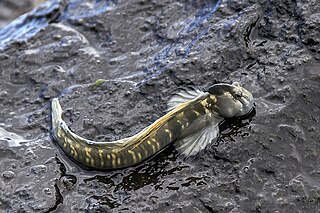
Alticus anjouanae is a species of combtooth blenny in the genus Alticus. Fourmanoir originally placed this species in the genus Andamia. It is a tropical blenny known from Comoros, Seychelles, and Réunion, in the western Indian Ocean. Males can reach a maximum total length of 7.6 centimetres (2.99 inches). Blennies in this species are oviparous and form distinct pairs when mating. They feed primarily off of benthic algae and weeds.

The Kirk's blenny is a species of combtooth blenny in the genus Alticus. It was described by A. Günther in 1964, originally as a member of the genus Salarias. It is a tropical blenny which is known from the Red Sea, Mozambique, Réunion, the Persian Gulf, and India, in the Indian ocean. Kirk's blennies inhabit waters near the shore, and often spend time out of the water. They are able to breathe air when on land. They are oviparous, and form distinct pairs when mating; they also guard their eggs.
Alticus montanoi, Montano's rockskipper, is a species of combtooth blenny in the genus Alticus. It is a tropical blenny, and is known from the South China Sea, in the western Pacific Ocean. The blennies are oviparous, and form distinct pairs when mating. They feed primarily off of benthic algae.

The leaping blenny, also known as the jumping blenny, is a species of combtooth blenny in the genus Alticus. There is some uncertainty as to whether it was first described by J.R. Forster in 1788 or B.G.E. Lacepède in 1800, although Fishbase currently accredits it to Forster. It was originally described as a member of the genus Blennius.
Andamia reyi, the suckerlip blenny, is a species of combtooth blenny found in coral reefs in the Pacific and Indian Oceans.
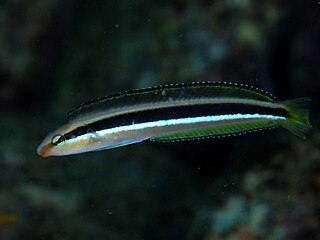
Aspidontus dussumieri, the lance blenny or Dussumier's blenny, is a species of combtooth blenny found in coral reefs in the Pacific and Indian Oceans. The specific name honours the French explorer and merchant Jean-Jacques Dussumier (1792-1883).
Dodekablennos fraseri is a species of combtooth blenny found in the western Indian Ocean, around Réunion and Mauritius. This species is a resident of tide pools where it can be found at depths of from 0 to 2 metres. This species is the only known member of its genus. Its specific name honours Thomas H. Fraser of the Mote Marine Laboratory who collected the type.
Litobranchus fowleri, Fowler's rockskipper, is a species of combtooth blenny found in coral reefs in the western Pacific ocean. It can reach a maximum length of 3.5 centimetres (1.4 in) SL. This species is currently the only species in its genus. The specific name hours the American ichthyologist Henry Weed Fowler (.
Lupinoblennius nicholsi, the highfin blenny, is a species of combtooth blenny found in the western Atlantic ocean, on the coasts of the Gulf of Mexico in north-eastern Mexico and Texas, it has also been recorded from Englewood, Florida. This species reaches a length of 6 centimetres (2.4 in) TL. The specific name honours the American ichthyologist John Treadwell Nichols (1883-1958).
Lupinoblennius paivai, Paiva's blenny, is a species of combtooth blenny endemic to a small area Brazil from Bahia to Santa Catarina where its habitat is the tidal reaches of coastal streams and small rivers. This species can grow to a length of 5.1 centimetres (2.0 in) SL. The specific name honours the Brazilian oceanographer João de Paiva Carvalho (1903-1961) of the Instituto Oceanográfico da Universidade de São Paulo in recognition of his cooperation with Pinto.

Omobranchus germaini, Germain's blenny, is a species of combtooth blenny found in coral reefs in the western Pacific ocean.
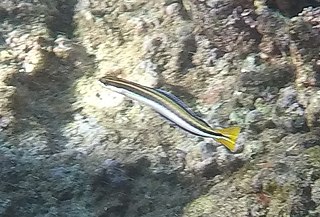
Plagiotremus goslinei, the biting blenny, Gosline's fangblenny, scale-eating blenny or the scale-eating fang blenny, is a species of combtooth blenny found in coral reefs in the eastern central Pacific Ocean. This species reaches a length of 6.3 centimetres (2.5 in) SL. The specific name honours the American ichthyologist William A. Gosline (1915-2002) of the University of Hawaiʻi.
Rhabdoblennius snowi, Snow's rockskipper or the Snow blenny, is a species of combtooth blenny found in coral reefs in the Pacific ocean. This species reaches a length of 7 centimetres (2.8 in) TL. The specific name of this blenny honours the collector of the type, the missionary Benjamin Galen Snow (1817-1880).

Salarias patzneri, Patzner's blenny, is a species of combtooth blenny found in coral reefs in the western central Pacific ocean. This species can reach a length of 5.5 centimetres (2.2 in) TL. The specific name honours the Austrian ichthyologist Robert A. Patzner who worked on the genitalia of blennies and who shared specimens with Hans Bath.
Ecsenius collettei, known commonly as the Collete's blenny in Papua New Guinea, is a species of combtooth blenny in the genus Ecsenius. It is found in coral reefs in the western central Pacific ocean, specifically in Papua New Guinea. It can reach a maximum length of 5 centimetres. The blennies feed primarily off of plants, and benthic algae and weeds. he specific name honours Bruce B. Collette the Director of the National Marine Fisheries Service Systematics Laboratory, whose collection of fish specimens from New Guinea contained a number important blenniid specimens, one of which was this species.
Xiphasia matsubarai, the Japanese snake blenny, is a species of combtooth blenny found in the western Pacific and Indian oceans just extending into the Atlantic Ocean in False Bay, South Africa. This species can be found at depths ranging from the surface to 4,960 m (16,270 ft). This species reaches 30 cm (12 in) in SL. This species feeds primarily on bony fish, rising to the surface at night to feed. It can also be found in the aquarium trade.
Coralliozetus rosenblatti, the spikefin blenny, is a species of chaenopsid blenny found in coral reefs in the eastern central Pacific ocean. It can reach a maximum length of 3.5 centimetres (1.4 in) TL. This species feeds primarily on zooplankton. The specific name honours the ichthyologist Richard H. Rosenblatt (1930-2014) of the Scripps Institution of Oceanography.










